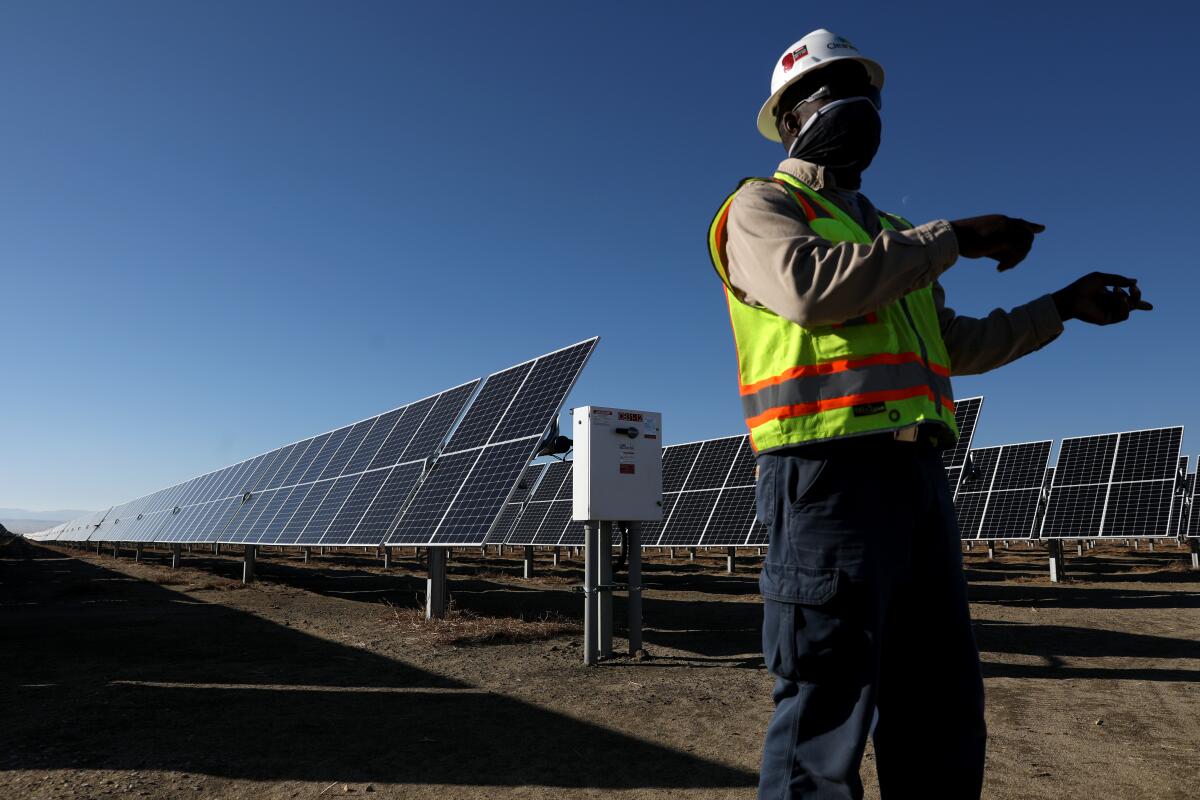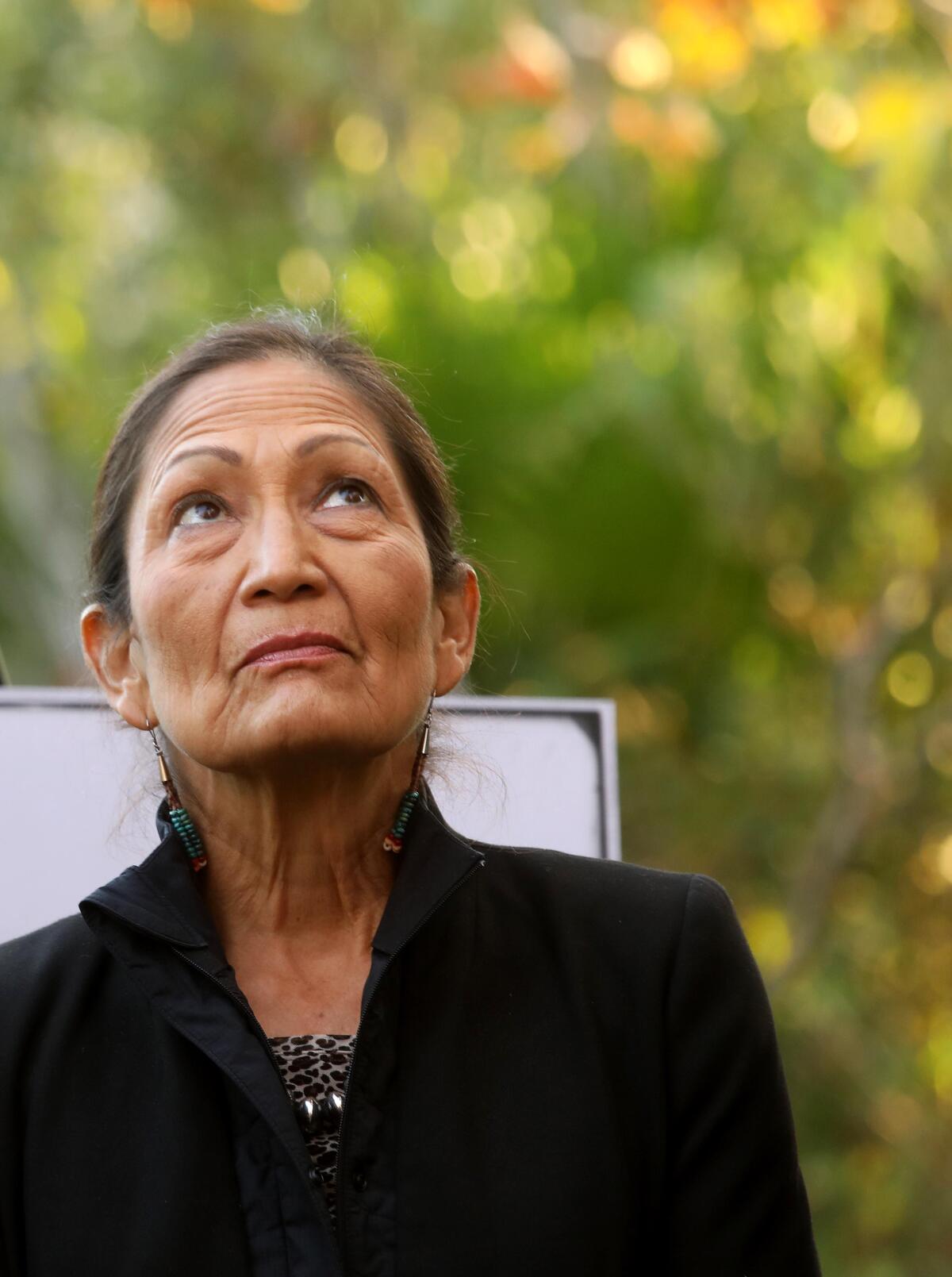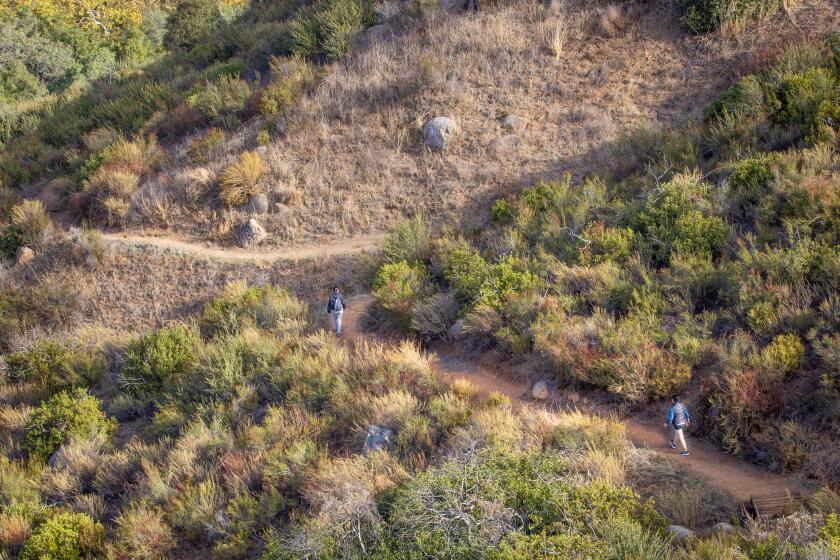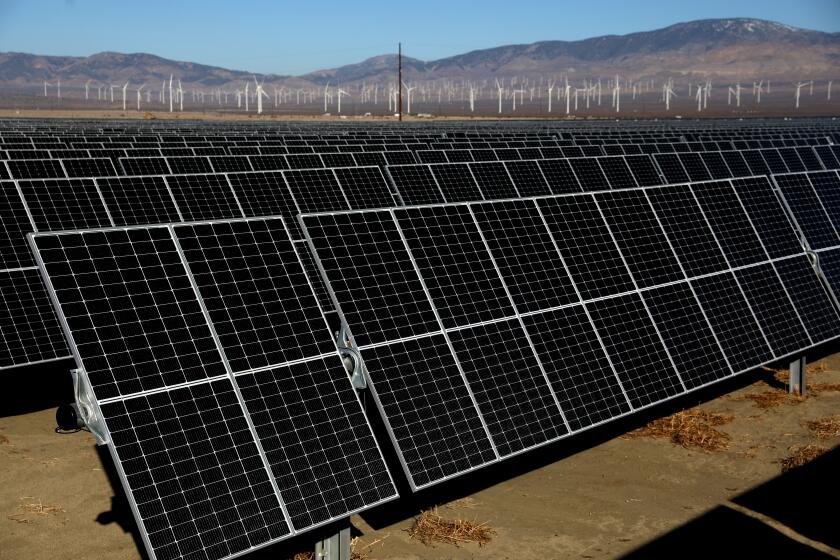Biden’s climate bill might be dead. But he just approved two huge solar farms

- Share via
The Interior Department gave the green light Tuesday to two huge solar farms in the California desert — a reminder that the Biden administration still has tools to combat climate change even if it can’t pass the president’s “Build Back Better” bill.
The two solar plants could eventually cover 2,700 acres in Riverside County, an hour’s drive east of Palm Springs and just south of Joshua Tree National Park. Federal officials say they would generate enough electricity to power some 132,000 California homes.
That energy would help keep the lights on after dark, with the developer also building a bank of lithium-ion batteries.
A third solar farm in the same area, which the Biden administration said it expects to approve soon, would bring total clean power generation at the new facilities to nearly 1,000 megawatts of solar and 900 megawatts of four-hour battery storage.
Your guide to our clean energy future
Get our Boiling Point newsletter for the latest on the power sector, water wars and more — and what they mean for California.
You may occasionally receive promotional content from the Los Angeles Times.
Approving renewable energy facilities on public lands is no substitute for national climate legislation, in terms of how much planet-warming pollution might be avoided. But these projects can still displace fossil fuels — and they don’t need the approval of Senate Republicans or coal-state Democratic Sen. Joe Manchin III of West Virginia, who have blocked Build Back Better.
“We absolutely have to move forward as much as we can with clean energy,” Interior Secretary Deb Haaland said in an interview.
At the same time, the new solar farms offer a reminder that the transition to renewable power — although badly needed to limit the worsening wildfires and deadlier heat waves of the climate crisis — comes with its own environmental challenges.
Across the American West, conservation groups and tribes have grown increasingly concerned about the potential for solar, wind and geothermal power plants to destroy sensitive wildlife habitat and disrupt sacred landscapes. Federal officials are grappling with those concerns as they try to meet a congressional target of permitting 25,000 megawatts of renewable energy on public lands by 2025, while also protecting 30% of the nation’s lands and ocean waters by 2030 as part of Biden’s “30 by 30” initiative.
Federal plans would complement California’s initiative to conserve 30% of land and 30% of coastal waters by the end of the decade.
Nowhere is the tension between conservation and clean energy more apparent than in California’s Riverside County, which is already home to half a dozen large solar farms operating or under construction, with many more planned. Vast expanses of sunny, undeveloped land between the Coachella Valley and the Arizona state line have attracted developers for more than a decade.
Riverside County ultimately became a role model for the Desert Renewable Energy Conservation Plan, which state and federal officials said was needed to resolve the conflict between development and conservation. Finalized during the last months of the Obama administration, the plan designated a few hundred thousand acres of federal land in California for clean-energy projects. It protected millions more, in hopes of preserving wildlands for desert tortoises, bighorn sheep, golden eagles and other species.
The newly approved Arica and Victory Pass solar farms are the first projects to be greenlighted under the desert plan. Haaland told The Times that she sees the plan as a model for other Western states as more solar and wind facilities are proposed for public lands.
“It really does take a hard look at conservation,” she said. “They do whatever they can to ensure that these species are protected.”
But from the solar industry’s perspective, just because two projects were approved doesn’t mean the desert plan is working.
For every facility getting the federal go-ahead, “there are projects that aren’t even getting proposed because it’s so difficult to navigate,” said Shannon Eddy, executive director of the Large-scale Solar Assn., a Sacramento-based trade group. She said the “conservation management actions” in the desert plan, which require companies to take steps to reduce the environmental impacts of their projects, are so restrictive that sometimes companies can’t build even in designated development zones.
For instance, in Imperial County in California’s far southeastern corner — another windy, sunbaked mecca for renewable energy developers — Eddy said only 11,000 acres out of 53,000 designated for clean power are realistically usable for solar.
“It’s difficult to find areas where you can actually put projects,” she said.
Policymakers are looking to California to show it’s possible to phase out fossil fuels. But, as rolling blackouts last summer showed, challenges lie ahead.
As if to illustrate that point, the Center for Biological Diversity has raised concerns about Arica and Victory Pass. Even though both solar farms would be built in areas designated for clean energy, they would still disrupt sand dunes that provide a home to Mojave fringe-toed lizards, as well as a crucial wildlife connectivity corridor, the center said.
But in a victory for the state and federal officials, the conservation group isn’t opposing Arica or Victory Pass.
“They did conform to what the [desert plan] laid out,” said Ileene Anderson, a scientist at the Center for Biological Diversity.
The two solar farms are being developed by San Francisco-based Clearway Energy Group, which plans to start construction on the first phase of each facility next year. The company has contracts in place to sell electricity to four government-run energy providers — including the Clean Power Alliance in Los Angeles and Ventura counties — as well as PepsiCo.
The projects could eventually include 465 megawatts of solar power and 400 megawatts of battery storage, and will “provide clean, reliable, affordable power when California needs it most,” Clearway executive Julia Zuckerman said in an email.

Conservationists objected more loudly to the third solar farm touted by the Biden administration, known as Oberon.
In a September letter, a coalition including the Center for Biological Diversity, Defenders of Wildlife and the Sierra Club criticized the Bureau of Land Management for proposing an exemption to the desert plan that would allow the project’s developer to destroy a few dozen acres of microphyll woodlands, where ironwood and palo verde trees grow along ephemeral streams that flow during monsoons, nourishing mammals and migrating birds. Anderson called those areas “the veins of the desert.”
But most of the groups that signed the letter reached an informal agreement with Oberon’s developer, Intersect Power, on Tuesday. In exchange for the company agreeing to pull back from desert woodlands in most places, the conservation groups agreed not to oppose the solar farm — assuming the changes are approved by federal officials.
“This project represents one of the largest habitat mitigation efforts of any energy development project in California’s history, and is a great example of clean energy and conservation going hand-in-hand,” Intersect spokesperson McKinley Doty said in an email.
For some conservation groups focused on protecting wildlife habitat and undisturbed landscapes, large solar and wind farms are almost always problematic. They’d much prefer to see solar panels covering rooftops, warehouses and parking lots — and they’re furious with a recent proposal from Gov. Gavin Newsom’s appointees that would slash incentives for those projects.

But most major environmental groups working on clean energy and public lands don’t want to thwart all development — they just want to see projects built in the least damaging spots. Haaland said that’s the Interior Department’s priority, too.
“We’re always trying to balance everything,” she said. “But, I mean, look: If we don’t move into a clean energy economy, climate change will get worse. More plants and animals will die.”
Getting permission to build a solar or wind farm on federal land can take several years, in part due to rigorous environmental reviews. And despite Biden’s emphasis on fighting climate change, before this week the Interior Department had approved just one new solar farm and zero wind farms on federal lands since Biden took office, as The Times recently reported.
Since then, Interior’s Bureau of Land Management has taken steps to spur more clean power projects.
On Monday, the bureau announced it is seeking developers interested in building solar across nearly 90,000 acres in Colorado, Nevada and New Mexico. A few weeks earlier, the agency said it would lower the fees paid by solar and wind developers.
There’s also a big backlog of projects waiting to be reviewed. The bureau says it is processing applications for 54 solar projects, four wind projects and four geothermal projects across the nearly 250 million acres of public lands that it manages — about one-tenth of the country’s surface area, nearly all of it in the West. Preliminary review is underway for another 64 applications.
Support our journalism
Your support helps us deliver the news that matters most. Subscribe to the Los Angeles Times.
Asked about the slow pace of project approvals so far, Haaland pointed to the Trump administration’s decision to move the Bureau of Land Management’s headquarters to Colorado from Washington, D.C. — a decision Haaland chose to reverse.
“There was a mass exodus of BLM career staff, really good long-term career staff who left the bureau when they were given an ultimatum of either to quit or move,” she said. “So we’re working on all that at the same time.”









